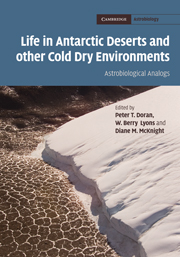Book contents
- Frontmatter
- Contents
- List of contributors
- 1 Introduction
- 2 Geologic analogies between the surface of Mars and the McMurdo Dry Valleys: microclimate-related geomorphic features and evidence for climate change
- 3 The legacy of aqueous environments on soils of the McMurdo Dry Valleys: contexts for future exploration of martian soils
- 4 The antarctic cryptoendolithic microbial ecosystem
- 5 Antarctic McMurdo Dry Valley stream ecosystems as analog to fluvial systems on Mars
- 6 Saline lakes and ponds in the McMurdo Dry Valleys: ecological analogs to martian paleolake environments
- 7 The biogeochemistry and hydrology of McMurdo Dry Valley glaciers: is there life on martian ice now?
- 8 Factors promoting microbial diversity in the McMurdo Dry Valleys, Antarctica
- 9 Other analogs to Mars: high-altitude, subsurface, desert, and polar environments
- Index
- References
5 - Antarctic McMurdo Dry Valley stream ecosystems as analog to fluvial systems on Mars
Published online by Cambridge University Press: 06 July 2010
- Frontmatter
- Contents
- List of contributors
- 1 Introduction
- 2 Geologic analogies between the surface of Mars and the McMurdo Dry Valleys: microclimate-related geomorphic features and evidence for climate change
- 3 The legacy of aqueous environments on soils of the McMurdo Dry Valleys: contexts for future exploration of martian soils
- 4 The antarctic cryptoendolithic microbial ecosystem
- 5 Antarctic McMurdo Dry Valley stream ecosystems as analog to fluvial systems on Mars
- 6 Saline lakes and ponds in the McMurdo Dry Valleys: ecological analogs to martian paleolake environments
- 7 The biogeochemistry and hydrology of McMurdo Dry Valley glaciers: is there life on martian ice now?
- 8 Factors promoting microbial diversity in the McMurdo Dry Valleys, Antarctica
- 9 Other analogs to Mars: high-altitude, subsurface, desert, and polar environments
- Index
- References
Summary
Introduction
The stream systems of the McMurdo Dry Valleys of Antarctica represent a relatively simple end member of terrestrial hydrologic systems. Many Dry Valley streams are prominent landscape features, especially in summer when they carry glacial meltwater from the alpine and outlet glaciers to the perennially ice-covered lakes on the valley floors (Fig. 5.1). Observations beginning in 1968 indicate that these channels carry water for 8–12 weeks each year, though some are only wetted in warm, high flow years, and others have been deactivated because of changes to flow routing. In addition to obvious channels incised in the landscape, smaller, less frequent fluvial features may become active in the Dry Valleys, such as small rivulets (shallow, broad gullies that are not wetted annually) carrying snowmelt or meltwater from buried ice down steep valley walls in particularly warm summers. Although these fluvial systems are relatively unique on Earth, the surface of Mars holds evidence of ancient fluvial features that are similar to snowmelt rivulets observed in the Dry Valleys.
In this chapter, we compare the contemporary status and function of streams of the Dry Valleys with those that may have existed on ancient Mars. Our current understanding of martian fluvial processes is limited to what can be inferred by the “leftover” drainages that are readily observed, some of which are quite large.
- Type
- Chapter
- Information
- Life in Antarctic Deserts and other Cold Dry EnvironmentsAstrobiological Analogs, pp. 139 - 159Publisher: Cambridge University PressPrint publication year: 2010
References
- 2
- Cited by

